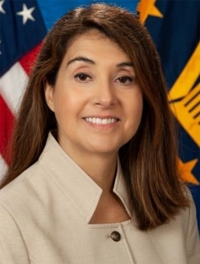
Teresa Riffel, VA’s deputy assistant secretary for Financial Management Business Transformation (FMBT)
WASHINGTON, DC — VA is slowly rolling out its Integrated Financial and Acquisition Management System (iFAMS), which seeks to replace a 40-year-old legacy system and shore up a material weakness that leaves the department unable to accurately track billions in expenditures.
According to VA officials, the undertaking is going as planned, but legislators worry that it might suffer from the same pitfalls as other major department IT projects, including poor coordination with VA, extremely long rollout schedules and mishandled contracting with developers.
“[This is] VA’s third attempt to modernize its hodgepodge of aging financial and accounting systems,” declared Rep. Matt Rosendale (R-MT), at a House VA Technology Modernization Subcommittee hearing on the issue. “Every year VA barely manages to pass its financial audit with a clean opinion, despite carrying the same material weaknesses and deficiencies for a decade. At the same time, the department’s purchase card spending continues to be similar to the Wild West.”
“With so many purchase cards at so many facilities and no central tracking, the department is basically helpless to enforce its policies, much less root out waste and fraud,” he continued. “Basic financial management stretches the capabilities of the system. Like tracking when the department transferred the CARES and [American Rescue Plan] funds. When the committee asked basic questions about how the funding was handled during last month’s hearing, the VA witnesses struggled to answer.”
Rosendale was quick to add that he did not believe the iFAMS project was another electronic health record modernization program but was worried that the rollout was going too slowly when VA needed better financial tracking now.
Teresa Riffel, VA’s deputy assistant secretary for Financial Management Business Transformation (FMBT), told the subcommittee that iFAMS is “no longer proof of concept” and has been up and running in select offices at VA for the last three years.
“It’s in use in 20 offices and with over 4,700 users,” Riffel said. Those offices include the National Cemetery Administration, the Office of Information and Technology, Office of Inspector General, part of the Office of Acquisition, Logistics, and Construction, as well as certain parts of VBA.
In contrast to the current system, iFAMS will allow VA to better track what a purchase was for, what pool of funding it should be filed under, who approved it and require additional levels of approval for high-dollar transactions. It will also comply with the reporting requirements from the Office of Management and Budget and the Department of the Treasury, which VA’s current system is unable to do and has led to “extensive and inefficient manual workarounds.”
“Antiquated systems limit our ability to have strategic decision-making capability; for us to be able to look across the enterprise and make decisions on changes in priorities and changes in the day to day,” explained VA Chief Financial Officer Charles Trapp. “It also limits our ability to implement new legislation, to see how it’s been spent and how quickly it’s been spent without resorting to Excel spreadsheets and other things offline. You certainly want to be able to use your system of record to be able to capture that information.”
This will be VA’s third attempt to replace its financial management system in the last 20 years. According to Nick Dahl, deputy assistant VA inspector general for Audits and Evaluations, the first two attempts failed because of “decentralized oversight, unrealistic timelines, inadequate management of all stakeholders and minimal testing.”
“I’m very hopeful that iFAMS is going to be successful,” Dahl said. “Because we’re dealing with a system that’s 40 years old, and it’s not meeting the needs. I really think it’s vital that VA do everything it can to get this system online.”
The system is not expected to roll out to the majority of VHA for another 4 years and won’t be completed at VBA until 2029. However, Riffel noted that 70% of all expected users at VBA are working with the system now.
As for VHA, difficulties with other IT projects, most notably VA’s failed attempt to implement a new supply chain management system, may throw a monkey-wrench into the iFAMS rollout.
According to Riffel, despite not knowing what supply chain solution VHA will eventually adopt, the iFAMS project will still move forward by integrating with the department’s current legacy system. Once a new supply chain management system is adopted, they will have to go back and reintegrate iFAMS into that new system. While this might mean additional costs and a duplication of efforts, Riffel stressed that VA needs to move to iFAMS as quickly as possible.
“VA cannot continue to rely on its legacy financial management system due to the enormous risk it presents to VA operations,” she declared.
